
69 minute read
SPORTS
O to college, adulthood and college sports
‘Having your own bedtime’ part of adjustment for former high-school athletes
BY BY STEVE SMITH SSMITH@COLORADOCOMMUITYNEWSPAPERS.COM
It’s a rite of passage.
High-school students swap the comforts of home, home-cooked meals and laundry services in exchange for the fi rst taste of responsibility, fi nding their own meals and ways to keep their clothes clean.
Welcome to college.
While it’s quite the switch for the majority of college freshmen, those who choose to be athletes have to budget in practice time, fi lm sessions, game days/nights and travel into their new-found routines.
We talked with almost a dozen former high-school athletes about their fi rst year in college. In the fi rst of a three-part series, they discuss the basic adjustment to college and how well they handled it.

Adjustment highlights
Vershon Brooks played football at Brighton High School. He’s doing the same at Luther College in somewhere.
“The adjustment from high-school to college sports was defi nitely noticeable right away,” he said. “The small details in every little think you do matter. Little details in how you train, how you practice all adds up, and it will show on the fi eld. Honestly, there was nothing really tougher. Only thing I can say that got tougher was just the speed of the game.”
Chase Prestwich, who played baseball at both Brighton and Frederick high schools, said there was lots of adjusting.
“Everyone is stronger, faster and bigger in college sports. It is something you have to get used to,” said the Northwestern State freshman. “Baseball in college requires a lot more time. The days are longer - practices, team meetings, going for treatments, looking at videos, etc. I’d say adjusting to the strength of everyone has been the hardest part.”
Former Frederick basketball player Izayah Elize agreed with the strength piece.
“Only 7% of athletes play at the next level, so obviously you have to be elite to play,” he said.
His former classmate, Ryan Chacon, winner of two state track-and-fi eld titles as a senior last spring, said there was lots to factor into his adjustments. He’s running cross country at Butler Community College in El Dorado, Kansas.
“For me, a key one was time management,” Chacon said. “It’s a big key in college and determines your character to the coach.”
Adams City alum and multi-sport athlete Gerardo Caldera chose Waldorf College and its football team.
“When I fi rst got here, things ran faster than what they did in high school,” he said. “Everything here is at a faster pace, and you either keep up with it or you get left behind.”
Former Stargate School student and Legacy High School swimmer Emma Kulbida took her talent to Carnegie Mellen, an NCAA Division III school in Pittsburgh.
“The good thing about choosing to compete at a D3 level was the lower commitment to athletics. However, even at a D3 level the commitment level is very high,” she said. “We practice eight times a week, including lifts. So the practice time commitment is similar to what it was in high school.”
The actual meets (each weekend, she said) take up “lots of time.”
“The diffi culty of training depends on how much effort you are willing to put into practices, so that stayed the same for me going from high school to college,” she said. “However, the time commitment increased, and it has been really diffi cult to fi gure out how to balance school and swimming.”
Her former classmate at Stargate, Madison Roecker, is on the cheer team at Nebraska-Wesleyan.
“The adjustment from high school to college sports was slightly diffi cult at fi rst,” she said. “I had to learn how to manage my time better to account for longer practices alongside a more rigorous academic schedule.”
Another Stargate alum, Erica Derby, played soccer for Northeast Community College in Norfolk, Nebraska. She said she didn’t have to make much of an adjustment.
“For the soccer side, everything stayed almost the same. Except we practice in the morning before school, not after school like in high school,” she said. “There was a bit of an adjustment for my classes, though. In high school I was used to having every class every day and homework for that class every night.”
That changed this year.
“I have classes two or three times a week, which makes the homework due in two days, not one,” Derby said. “It took me about a week or so to get used to that. Other than that, everything was a smooth transition for me. I have a lot more free time that I did in high school. But soccer fi lls some of that, and the rest I use to study.”
Former Riverdale Ridge baseball player Dakota Pruitt had a built-in advantage for his fi rst year at Otero Junior College.
“The switch from high-school to college athletics was pretty easy,” he said. “I had a lot of help from older friends and my brothers. They gave me advice and ways to make it through. So without them, I would be a lost puppy.”
Brighton High School alum Eli Bowman played football at the South Dakota School of Mines.
“At fi rst, the adjustment from high school to college football is pretty big,” he said. “I was defi nitely humbled being surrounded by guys that are bigger, faster and stronger. The overall mindset was a big change too. In high school, not everyone was as committed as me. But in college,



Frederick’s Izayah Elize faces o against two players from Mountain View March 2021 photo. FILE PHOTO

everyone has the same winning mindset, so the coaches and the players all expect a lot more from you.”
Former Brighton swimmer Jespyn Bishop chose to play water polo at McKendree University in Lebanon, Illinois. He called his adjustment “defi nitely weird,” in part because water polo is not a sanctioned sport in Colorado.
“ I just had my club team on its own, unlike some of my teammates and other athletes who had both,” he said. “The change though was defi nitely a little overwhelming at fi rst. The level of play I came into was much higher than what I was used to.”
His team had more weekly training and weight sessions.
“It defi nitely took me a few weeks to get in gear, but eventually with repetition and motivation from my teammates I got the hang of it all,” Bishop said. “I would have to say the most diffi cult part about it was that as soon as I arrived, we pretty much had to jump into season. We had our preseason/tryouts for the D2 roster in the fi rst two weeks. I ended up being one of four freshmen to make the varsity roster, which was pretty exciting.”
Graded adjustments
Derby said the switch for her was easy.
“I do miss my family but I enjoy the independence I have in college,” she said. “I made good friends on the soccer team.”
“Personally, I think I have handled the switch well,” Pruitt said. “It’s just getting used to having your own bedtime.”
Bowman thought he handled the switch well, too.
“At fi rst, it was a lot of work, but I was able to play in every game as a freshman, so that gave me some confi dence and incentive to keep going,” he said.
Brooks said his switch was “a little rough.”
“Leaving loved ones and friends has been the hardest part,” Brooks said. “My family is my biggest motivation in everything I do, so not seeing them on a daily basis was a big change.”
Roecker said she was able to acclimate to her new surroundings “quickly.”
“There’s defi nitely a learning curve” Kulbida said. “The fi rst couple months were defi nitely a struggle. Although it is far from easy now, I realized that time management and keeping a rigid schedule but still setting time aside to relax and take breaks has been extremely important. Also, I’ve learned the importance of prioritizing sleep and recovery.”
“The way I’ve handled the switch is I’ve stayed up some nights fi nishing homework and assignments just to stay on top of my academics, because I know my ability to work well on the fi eld but I’m also a student before an athlete,” Caldera said.
Chacon joined those who have handled the switch well.
“My teammates and coach pushed me so I can be the best I can be,” he said.
For his part, Bishop said it took some time to get used to the changes.
“I was in a totally new living situation as well,” he said. “I think it took a good portion of fi rst semester to get comfortable. I still am not fully comfortable, and I don’t think I ever will because being 12 hours from the place where I grew us is defi nitely weird. I am though starting to get use to the area here, which is good.”
“You’ve got to have confi dence and hold your ground,” Elize said. “It’s not always easy. But you have to have confi dence.”
“I have handled the switch fi ne,” Prestwich said. “I try to stay on a sleep schedule and overall routine, because I know my days will be long.”



Dakota Pruitt
FILE PHOTO
THECOLORADOSUNPRESENTS ENVIRONMENTAL, SOCIALAND GOVERNANCE


&TheCultureofBusiness

Learnhowcompaniesareimpactingyour liveswithinitiativessuchasgreenenergy, wastemanagement,pollutioncontrols, waterusage,fairlaborpracticesandmore!

ScantheQRcodetoregister, orvisit coloradosun.com/events





Frederick High School Warriors graduated 264 as the school’s class of 2024 celebrated the rite of passage with family and friends on a cloudy May 28.
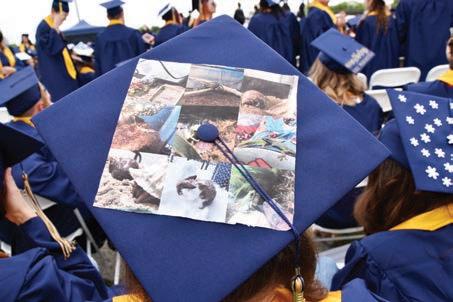

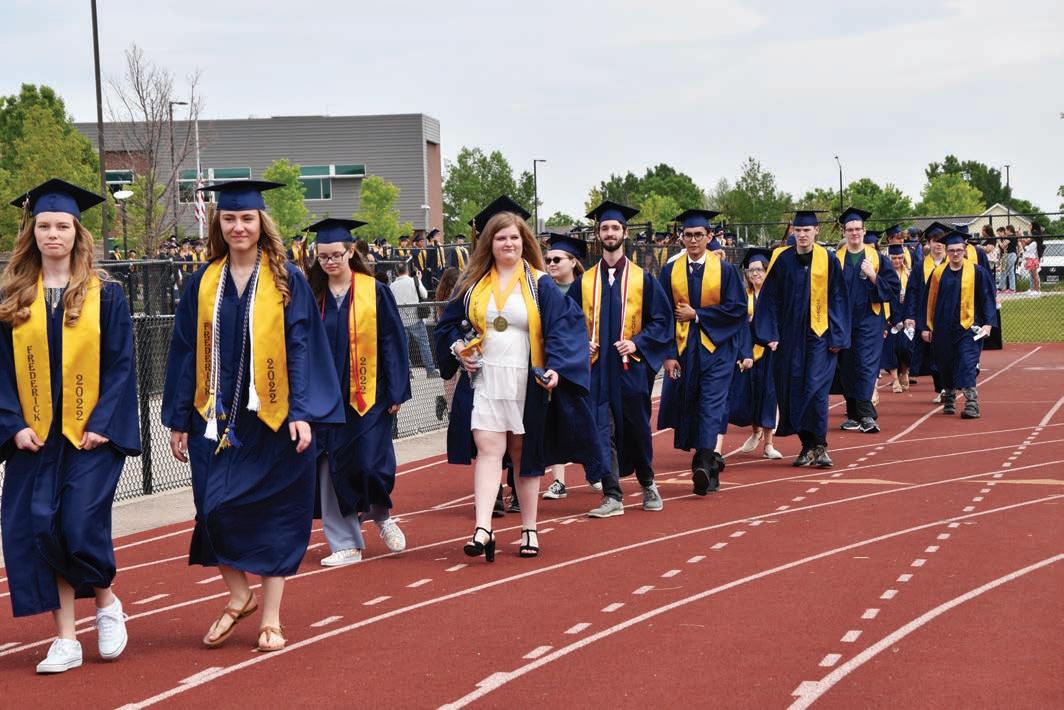


On Christopher Siverly’s cap is a collage of photos of all his pets. The Frederick High School students walked into a packed stadium with family and friends.
PHOTOS BY BELEN WARD
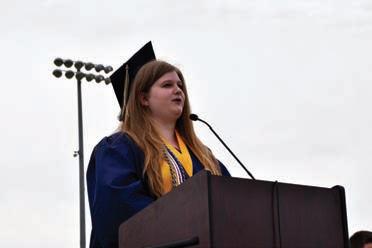
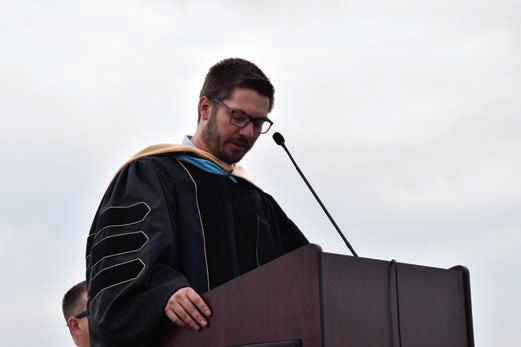

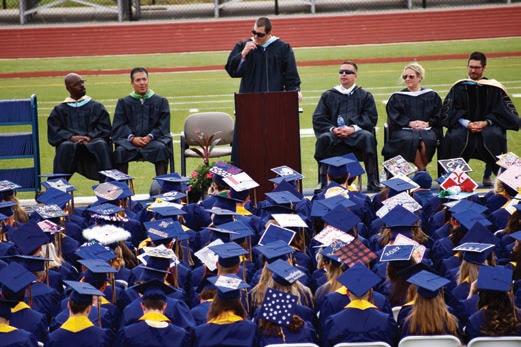


Valedictorian Nina Palmer speech, “teachers and administration, we are here because of your dedication to education who have infl uenced the future at least one in cap and gown today. Palmer is going to school to student zoology at Colorado State University. Left, Johnny Terrell assistant superintendent, Mr. Chico Garcia St. Vrain Valley School board member, Mark Allen commencement speaker, Doug Jackson assistant principal, and Ashlie Swanson Dean of Students. Principal Russell Fox gave a speech that the class of 2022 was the largest graduation class in Frederick History. “ So class of 2022 the last of the warriors, I wish you luck as you head into the world.”
Your Financial Assistance Home Equity Loans for Seniors—A Safe Option

by Matt Witt
Are you a homeowner 62 or older? Have you ever found yourself having to choose between buying food or medicine? How about having to put o a medical or dental procedure due to limited funds? If you have been faced with having to make a tough nancial decision of any kind stop reading and call 720-458-4034 to speak to the local reverse mortgage experts at Silver Leaf Mortgage right now. Did you know the proceeds from a reverse mortgage are tax-free money that may be used in any way you choose? For some it’s the instant, lifesaving help needed today. For others, it’s the safety net for your future or the unplanned life events like medical emergencies that may arise. Qualifying for a reverse mortgage, it’s simple and easy. Quali cation is based on these important factors: • You (the borrower) must own the home. • You must be 62+. (A non-borrowing spouse may be under 62.) • e home must be your primary residence (you live there at least six months and one day per year).
“I called to ask questions about accessing the equity in my home to help cover monthly expenses, but my son was against it. He doesn’t live with me or pay my bills, he just thought it was a bad idea. He spoke Even if you have bad credit, have had with my loan o cer, who was able to meet all of his objections. I am so glad I didn’t stop when my son said a bankruptcy, or a foreclosure, you are not disquali ed. In most cases there is a remedy for past credit problems. So, don’t think you can’t get the help you need.he didn’t like it!” Let us help you navigate these di cult Well-meaning children—unaware nancial times, call your local experts of recent safeguard changes the US at Silver Leaf Mortgage today at Government has put in place for 720-458-4034 to see if a Reverse reverse mortgage borrowers—may Mortgage is right for you. prevent their parents from moving forward with a transaction that would truly bene t them. Misinformation about reverse mortgages abounds. Get the facts. Objection #1: “Mom, the bank will own your home!” Actually, Mom never gives up the title to her home. Objection #2: “But Dad, there will be no inheritance for us kids!” Children do not realize that the property can be willed to the kids. With new safeguards (including lower lending limits and reduced mortgage insurance costs), the loan balance grows more slowly, allowing the heirs to decide to re nance or sell the home. Seniors have worked all their lives to provide for their families. Silver Leaf Mortgage, Colorado’s #1 Rather than struggling nancially Reverse Mortgage Broker. in retirement, they can unlock the Matt Witt, NMLS #1638881, equity in their home, and provide a President at Silver Leaf Mortgage more secure life in their golden years. in Centennial. Matt Witt, NMLS #1638881, Contact me at: 720-458-4034, or you can email me at: MattW@SilverLeafMortgage.com President at Silver Leaf Mortgage in Centennial.
Contact me at: 720-738-3773,
* e homeowner is still responsible for applicable property taxes and homeowner’s insurance, as well or you can email me at: as maintaining the property. MattW@SilverLeafMortgage.com
720-458-4034 720-REV-ERSE

Colorado’s #1 Reverse Mortgage Broker 30 Day Closings Guaranteed**Based on client scenario

Mortgage Company Reverse Mortgage Company Mortgage Agent Call within the next 30 days and choose one of these great offers: • A Free Appraisal • A Free Home Inspection choose one of these great offers: Don’t wait 4 months at the big lenders. Call Matt to get a
• $1,000 Paid Towards Closing Costs Offer Code 0101CCM 30 day closing.
Matt Witt Matt Witt
NMLS #1638881 President and Sr. Lending O cer Reverse Mortgage Specialist Silver Leaf Mortgage, Inc. 720-458-4034 2154 E. Commons Avenue, Suite 342 MattW@SilverLeafMortgage.com Centennial, CO 80122 O ce 720-738-3773 • Fax 303-362-7812 Matt Witt: Reverse Mortgage Expert! Listen to: The Reverse Mortgage Show Hosted by Matt Witt Legends 810 and 94.3FM, 670 KLTT, 100.7FM KLZ and 560 KLZ or see us live on Cell Phone 303-888-4531 Colorado’s Best KWGN CW2 & Fox-31, or Colorado & Company KUSA 9News mattw@silverleafmortgage.com • www.SilverLeafMortgage.com
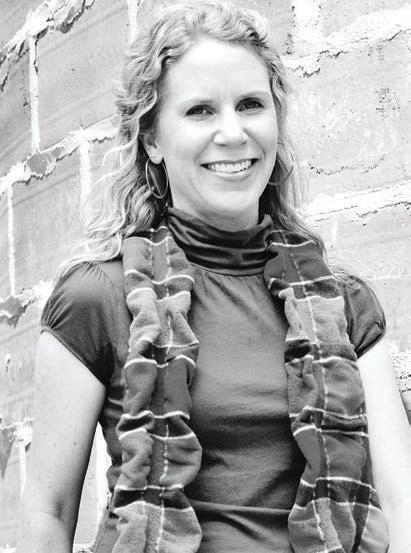
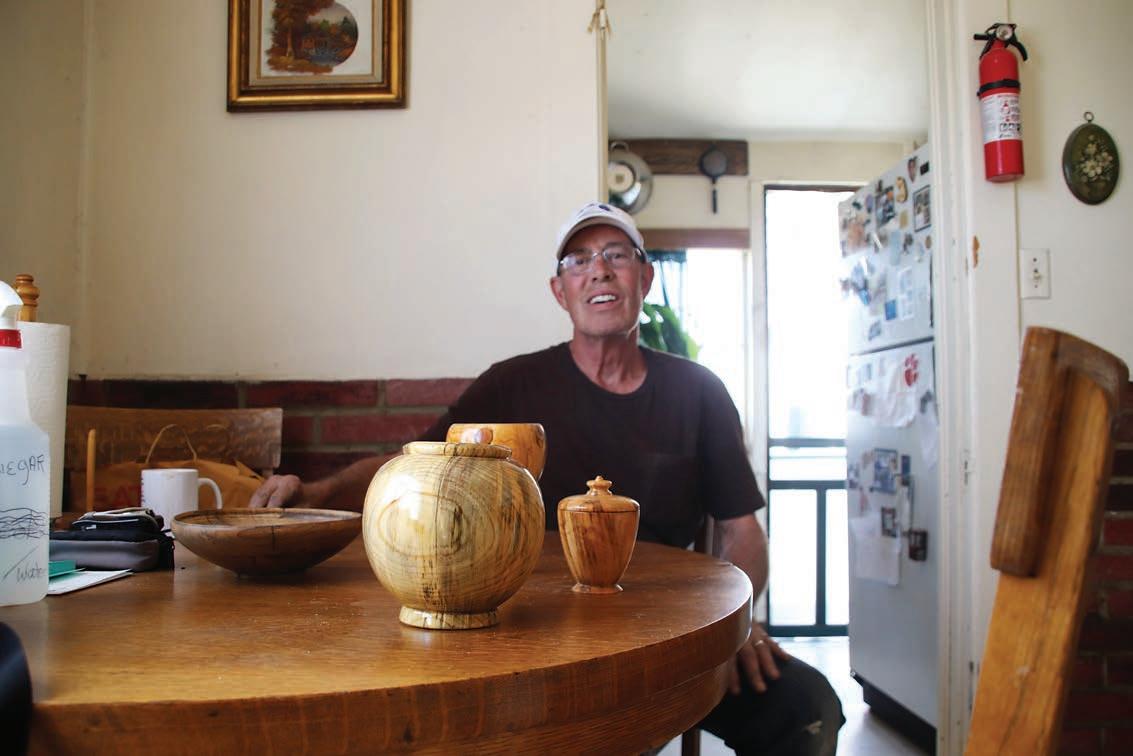
Wildfi re art creates beauty out of tragedy


BY LUKE ZARZECKI LZARZECKI@COLORADOCOMMUNITYMEDIA.COM

Robert Nesladek carves wood. He works in a sawdustfilled studio behind his house in Arvada, which he has owned for 47 years.
He uses two wood lathes to carve out bowls, vases and other works of art from wood charred by wildfires. One of those lathes was handed down from his grandfather to his dad, then to his uncle and now to him.
He started working with wood after he quit drinking.
“I had to find something to keep my hands busy,” he said.
Out of a devastating event, wildfire art aims to create something beautiful — a vase, a painting or a poem.
Nesladek transforms the wood burned by wildfires into beautiful shapes. He said burned wood takes on different characteristics because of the intense heat that dries out the log.
“It puts a lot of that charcoal gray color into the wood, and it just kind of runs through it,” he said. “It just is really nice to work with.”
Starting out, the wood is filthy.
“As soon as you touch it, you think ‘I’m not going to even mess with that stuff. It’s just nasty,’” he said. “But as soon as you get the bark off, it’s clean inside, and it’s dry.”
Nesladek turns the wood on the lathe quickly and shapes it with different chisels and blades. Once the burned charcoal coating the wood is removed, he starts to mold the center of the wood that endured intense heat but wasn’t directly touched the fire. After he reaches the shape he wants, he applies a clear stain.
“It amazes me how something so nasty, so devastating, can turn into something so beautiful,” Nesladak said.
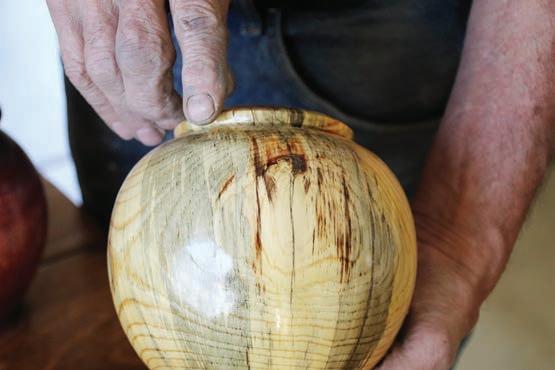
Painting from within
Creating art from wildfires can also help begin the healing process after such a tragedy.
For Alissa Davies, of Boulder, that involves intuitively painting emotions onto canvas.
After the Marshall Fire, Davies said she and her community felt an extreme sense of loss and fear.
“We’ve had these wildfires in our community, and every time the wind blows, we all feel this kind of collective trauma,” she said. “What’s going to happen to this place?”
Davies describes herself as an intuitive artist — stepping up to a canvas with no idea of what the end result will be. She looks inward to get in touch with her feelings and then paints.
After the Marshall Fire, she returned to her studio to begin addressing her emotions and out came Firescape 1, 2 and 3.
“We all are very affected by external events that happen around us,” she said. “(Painting) is just a highly therapeutic process for me.”
She said fires come with an immense, intense energy that she channeled into the paintings. She said she experienced those feelings even though she didn’t lose a house to the fire, but instead, she channeled the hardships of those who did.
She champions art therapy programs in Boulder and surrounding communities where people can learn to get in

SEE FIRE, P13


Radha Marcum COURTESY OF RADHA MARCUM
Robert Nesladek with three vases he created out of the leftover wood from a
wildfi re. PHOTO BY LUKE ZARZECKI



Alissa Davies posing in front of her series “Firescape.”
PHOTO BY LUKE ZARZECKI

A closeup on a vase made of wood
torched by a wildfi re. PHOTO BY LUKE ZARZECKI
The wood lathe Nesladek uses to
carve his wood. PHOTO BY LUKE ZARZECKI

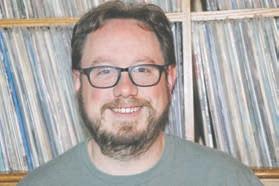
The Denver metro area really shines during the summer months. There are all kinds of outdoor options for dining, live music and activities, while classic concert spots and cultural hubs are still doing their thing. With such a bevy of options, you really can’t go wrong. But just in case, I’ve collected fi ve options to help start the season off proper.
Let the night shine bright at Earth Illuminated
As Ray Charles once sang “nighttime is the right time,” and the grand re-opening and debut of
Dark Mode at Earth Illuminat-
ed celebrates this very important truth.
Presented by the award-winning production team at Blazen Illuminations, the exhibit reopened at the Denver Pavilions, 500 16th Street Mall, Suite 280, with a new look and feel. According to provided information, Dark Mode wants guests to come away awed by the beauty of nature during nighttime. Each scene visitors explore makes use of theatrical lighting and immersive sound design, projection, special effects and more. There are more than 40 scenes spanning a 13,000 square foot space, with interactive props and more.
For more information and to purchase tickets, visit EarthIlluminated.com.
Thor lands at Red Rocks Red Rocks
Amphitheatre is back in the movie business with the full-time return of in-amphitheater fi lm screenings as part of its Film on the Rocks series. Gates open at 6:30 p.m. for every show, with musical guests taking the stage at 7 p.m., followed by the fi lm presentation at 8:30 p.m. And the season is starting with a blast of Marvel fun in the stellar “Thor: Ragnarok.”
The screening will be on June 13 at Red Rocks, 18300 W. Alameda Parkway in Morrison. For those who haven’t seen the fi lm, it’s the third in the Thor trilogy and director Taika Waititi lets the story and cast cut loose, resulting in one of the Marvel Cinematic Universe’s best entries.
Visit www.denverfi lm.org/programs/fi lm-on-the-rocks/ for the full schedule, information and tickets.
COMING ATTRACTIONS
Clarke Reader
Thor lands at Red Rocks Amphitheatre
back in the movie business with the full-time return of in-amphitheater fi lm screenings as part of its Film on
The Mugician comes to Dazzle Jazz
Jazz music is one of the few genres that maintains a passionate commitment to tackling current events going on both locally and on a grand scale. And Ferguson, Missouri’s, Keyon Harrold made one of the most stunning musical statements of the 2010s with his 2017 album, “The Mugician.” The album features contributions from extremely talented musicians like Gary Clark Jr., Robert Glasper and Bilal.
Harrold will be performing as part of Dazzle’s 2022 Keeping It Cool summer concert series, which features two Grammy awardwinning artists, a Colorado Hall of Famer and more. He’ll go live at 7 p.m. June 10 at Dazzle Jazz, 1512 Curtis St. in Denver.
Tickets and information can be found at www.dazzledenver.com.
Clarke’s Concert of the Week — The Hold Steady at the Bluebird Theater
We could all use a positive jam or two these days and that’s what Minneapolis’ The Hold Steady specialize in. Over the group’s eight albums and almost 20 years of touring they’ve built up a rabid fanbase thanks to Craig Finn’s incisive character sketches and the group’s bar-band soundscapes.
Last year they released one of their most acclaimed albums in years in “Open Door Policy,” but they’re stopping in Denver as part of a tour that was supposed to be in support of 2019’s great “Thrashing Thru the Passion.” The group is fi nally playing a three-night run at 8 p.m. June 16 and 9 p.m. June 17 and 18 at the Bluebird Theater, 3317 E. Colfax Ave.
The Hold Steady is truly one of the best live bands around right now and the Bluebird is the perfect venue for them. Get tickets at www.bluebirdtheater.net/events.
Arvada throws an epic pool party
Who doesn’t love a good pool party? Arvada’s Fitz Fest provides that on a large scale, with activities for everyone, whether they get in the pool or not.
The event will be held from 10 a.m.-1 p.m. June 18 at Fitzmorris Recreation Center, 6340 Independence St. The party includes three hours of swimming at the Fitzmorris outdoor pool, three bounce houses, Apex on Ice `ice’ skating, a yoga session, face painting, sports demonstrations, Ninja course, Imagination Playground, food and drink, carnival and yard games. In other words, practically all the summer fun a person could want.
Pre-register for Fitz Fest at https://apexprd.org/event/fi tzfest/.
Clarke Reader’s column on culture appears on a weekly basis. He can be reached at Clarke.Reader@hotmail.com.

touch with their emotions and put them onto paper.
Those programs give people space to freely create art. She touches on her semester in college at the Art Institute of Chicago where it wasn’t so free.
Her painting classes created an intense environment with critiques and competition from professors and students.
The art therapy classes were different, she said, in that they created a more encouraging environment.
“There’s that level of acceptance,” Davies said. “Instead of thinking art is for the precious few, it gives people the view that we all really know what to do with paint. It might not be pretty, and it might not look like what’s in our head, but that’s OK, and it’s better that way.”
For those affected by the Marshall Fire, art therapy can begin those conversations, both verbal and not.
“It’s always important to talk it out, but I think those nonverbal ways of expressing are equally as powerful and helpful,” Davies said.
Sometimes, it just takes a few breaths and a blank canvas.
To get in touch with her emotions before she paints, Davies mediates. While painting, she turns off her mind and moves very quickly.
“I’m constantly turning my canvas,” she said. “You can click over into that fl ow state, you know that feeling of when time kind of gets

Firescape 1, 2 and 3 by Alissa Davies.
weird, it’s suspended. It’s bliss.”
Burning wood
Radha Marcum of Boulder started writing at age 7 on her mother’s typewriter. Fast forward to today, and she’s a poet creating poems rooted in ecological, social and personal landscapes of the American West.
“I grew up in the West, so wildfi re has always really been in my awareness,” she said.
In 2019, she began writing more about wildfi res. The burning of the Notre Dame Cathedral in Paris triggered her new topic.
She visited the cathedral with her husband within weeks of the roof burning. Replacing the ceilings, made of oak beams from Europe’s ancient forests, remains almost impossible because those forests are long gone, she said.
“At the same time that we were losing this magnifi cent humanmade structure, we were also los-

PHOTOS BY LUKE ZARZECKI
ing nature’s cathedral,” she said. “I think of the old growth forests in North America.”
It reminded Marcum of visiting the Redwood forests in Northern California.
“Thinking about the history of people who have been in these places, whether it’s a cathedral or a forest, there’s a sense of continuity, and so when you lose a forest or you lose a cathedral, you’re losing that sense of continuity with ancestors and which people would come before you,” she said.
Hence, she started writing about wildfi re, and the Marshall Fire made the topic even more personal for her.
“When it happens in your backyard, and when you’re watching the effects in real time, that I think is profound,” she said. “I think in art, and in poetry, in our writing, we have the opportunity to meditate on what is happening right here, right in front of us.”
For her, that can mean looking at specifi c changes in her surroundings. One example she points to is a poem about a plum tree in her backyard that she moved inside due to the drought.
Another poem looks at smoke drifts and ashes falling in her backyard. Those ashes, she said, are forests, people’s homes or wildlife. Some fl oat in from other places.
“There’s a connection between different parts of the country, between you and the landscape, between the ecology, the trees, the wildlife,” she said. “We’re all affected by these events, whether or not they’re burning our structures, or they’re burning the forest.”
Marcum sees her poems as an invitation to readers to recognize the events happening around them.
“(It’s about) connecting with what’s really going on, rather than being sort of numb and overwhelmed by the news or by statistics,” she said.
Socioeconomic gaps between Black, Latino and white Coloradans narrowed, but equity remains ‘a dream unrealized’
Chasing Progress is a Colorado News Collaborative-led multi-newsroom reporting project examining the social, economic and health equity of Black and Latino Coloradans over the last decade. The project builds off 2013’s “Losing Ground,” an I-News/ RMPBS series that tracked similar measures from 1960-2010. We welcome stories of your experiences last decade as well as suggestions for future Chasing Progress stories at chasingprogress@ colabnews.co
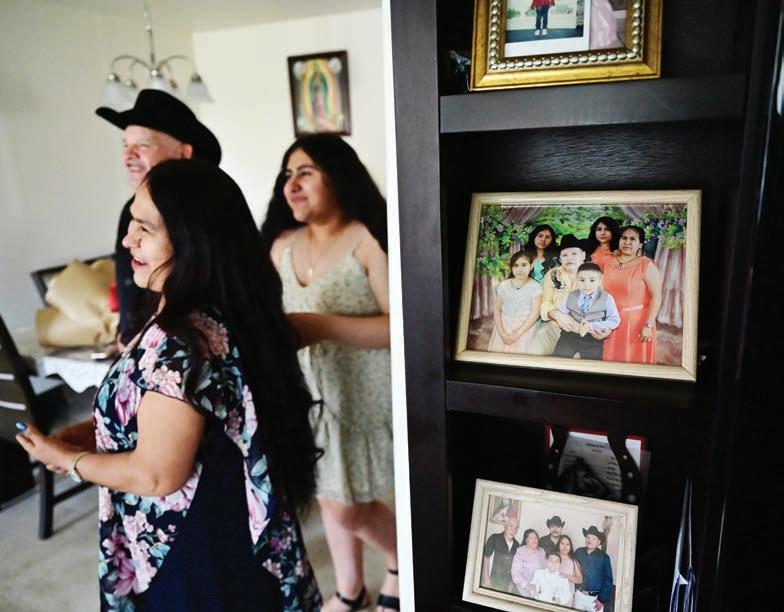
The family of Maria Bocanegra Tejeda, 22, not pictured, gets ready to leave the family’s house for Maria’s 2022 University of Northern Colorado graduation ceremony in Greeley, Colorado on May 7. Pictured are Maria’s parents Guadalupe Bocanegra, 59, top, and Raquel Tejeda, 49, front, and Maria’s sister Rosalinda Bocanegra Tejeda, 15. PHOTO BY HYOUNG CHANG/THE DENVER POST
BY TINA GRIEGO AND BURT HUBBARD COLORADO NEWS COLLABORATIVE
Maria Bocanegra Tejeda awakens as the rising sun lights her room. Her room. In the house her family owns. That fact is still capable of surprising her, so far removed it is from her cousins’ crowded trailer in the crowded mobile home park where she spent nearly half of her 22 years.
The night before, she draped her navy graduation robe over the chair near the bed. Her cap lay nearby, its mortarboard top emblazoned with the words: “Cultura es orgullo. Orgullo es exito.” Culture is pride. Pride is success. The rallying call of her University of Northern Colorado sorority.
She can hear her parents in the kitchen. Her dad would be running on a few hours of sleep after his shift at the beef processing plant and the hour-long midnight bus ride home from Fort Morgan to Greeley. What he feels about his daughter’s graduation, he later will say, is beyond his capacity to put into words. He walks around the house two hours before the ceremony wear-
SEE EQUITY, P15
PAID ADVERTISEMENT
New limits expand 401(k), IRA opportunities
You could spend a few decades in retirement. So, to pay for all those years, you’ll probably need to take full advantage of your IRA and 401(k). And in 2022, you may have expanded opportunities to do just that.

To begin with, the annual contribution limit for 401(k) plans is now $20,500 – up $1,000 from 2021. If you’re 50 or older, you can put in an extra $6,500, for a total of $27,000.
Also, the income range has increased for making deductible contributions to a traditional IRA. And the income range for making Roth IRA contributions has also increased. You’ll want to consult with your tax advisor to determine how these new limits might affect you.

When you’re saving for retirement, any new opportunities, of whatever size, can be valuable. So, review your options to determine how you can help yourself build the resources you’ll need to enjoy life as a retiree.
This article was written by Edward Jones for use by your local Edward Jones Financial Advisor.
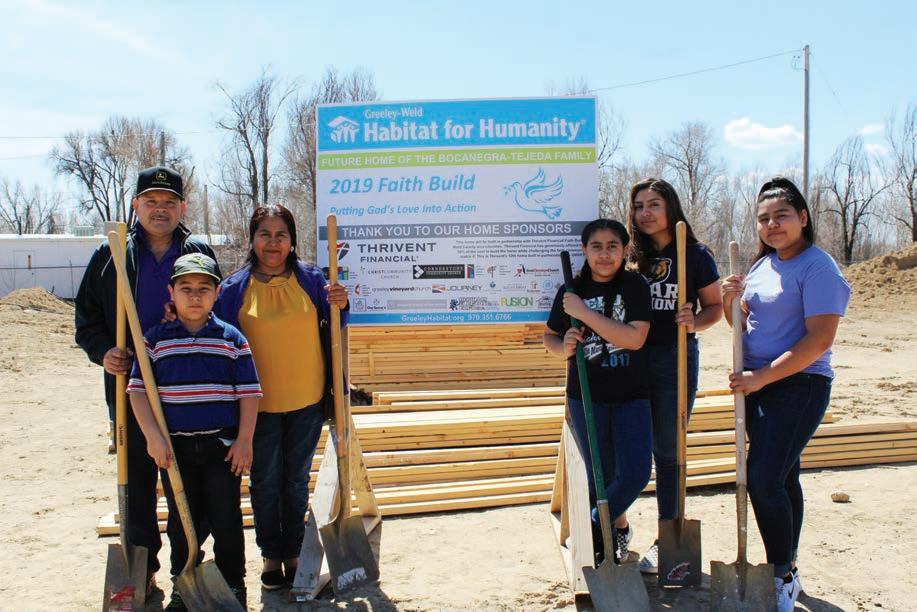
www.edwardjones.com Member SIPC Maria Bocanegra Tejeda, 22, puts on her graduation gown and cap for the 2022 University of Northern Colorado graduation ceremony at
her home in Greeley, Colorado on May 7. PHOTO BY HYOUNG CHANG/THE DENVER POST
Maria Bocanegra Tejeda’s decorated graduation cap for the 2022 University of Northern Colorado graduation ceremony photographed at her home in Greeley on May 7. The Spanish words translate to “Culture is Pride, Pride is
Success.” PHOTO BY HYOUNG CHANG/THE DENVER POST




The Bocanegra Tejeda family poses in front of a sign announcing the site of their future Habitat for Humanity home in Greeley at an April, 2, 2019, groundbreaking ceremony. From left, Guadalupe, Jose, Raquel, Rosalinda, Maria and Herminia.
ing a black cowboy hat and white jeans that puddle over his boots. He tries to keep his tears at bay. Maria’s mother does not even try.
Years ago, when her dad was driving past UNC, Maria pointed to the campus and told him, “One day, I’m gonna come here.” He, with three years of formal education, a laborer his whole life, told her the university was for rich people. She reminded him of this recently. Not to shame him, she says, but to acknowledge how far they had come since settling in Greeley in 2010.
In the decade that followed in this, one of the fastest-growing communities in one of the nation’s fastestgrowing states, the Bocanegra Tejedas worked their way from renters to homeowners, from a one-earner household on the poverty line to two earners with a monthly cushion big enough to ensure their mortgage did not devour them. Maria, the eldest of four, became the family’s fi rst high school graduate, its fi rst to enroll in college.
“It’s going to take a while to settle in,” Maria says as she curls her hair on graduation morning. “So much changed. In 2010, I didn’t know if college was a possibility and the optimism wasn’t there. But now, it’s not just dreams. Now, we have a foundation we can build on.”
Inching forward on shaky ground
The Bocanegra Tejeda family symbolizes the most hopeful version of the story of Colorado’s Black and Latino residents from 2010 to 2020. In several key measures of socioeconomic progress, each group moved a little closer to white Coloradans, who also saw many gains.
A Colorado News Collaborative (COLab) analysis of U.S. Census and other data found that over the course of the last decade, poverty rates among the state’s Black and Latino residents fell to historic or near-historic lows, high school graduation rates, particularly for Latinos, shot up, Black and Latino median household income climbed at rates that outpaced infl ation, and Latino homeownership cracked the 50% mark for the fi rst time since the Great Recession.
Nowhere else in the nation saw a greater narrowing of the gaps in poverty levels between Latinos and whites than Colorado. Our state was also among the top 10 that experienced narrowing gaps in median household income between Latino and white, and Black and white households.
Progress toward parity is progress toward equity, which, as Colorado Health Foundation President and CEO Karen McNeil-Miller puts it, “is essentially the American promise that people will have what they need in order to thrive economically, socially, spiritually, physically, emotionally.”
That thriving is the engine of Colorado’s future. Population projections show growth will be led by younger Latinos and African Americans, and more Coloradans of color will enter the workforce as aging white workers retire.
But if the upward trends tell one story, the underlying gaps tell another.
Progress was tempered by the reality that in the last decade a Black or Latino Coloradan was still twice as likely to live in poverty as their white neighbors, and Black median household income was two-thirds that of white. Even with the slight upward tick, the rate of homeownership — the main path to generational wealth — among Latinos here remained lower than it was in 1970, while the rate among Blacks hasn’t cracked the 50% mark since at least 1960.
Four-year college graduation rates among Latino residents 25 years and older inched upward during the decade, but still remained in the teens, 10 percentage points lower than Black Coloradans, and 31 points lower than white. The state’s long and acknowledged history of importing college-educated whites while failing to homegrow the potential of its youth of color created the nation’s largest Latinowhite higher education gap and the second-largest Black-white gap. Expand the defi nition of higher education to include two-year degrees and career-technical certifi cations, and Black and Latino Coloradans attainment rates still remained a fraction of their white peers.
When three of every four students who made up the growth in the state’s high school population over the last decade were Latino, the consequences of the failure to ensure more can achieve a higher education are obvious.
“If we don’t (close the gaps), we will continue, decades on, the way we have decades past where we have this blaring equity gap, and we have unfulfi lled, unactivated potential,” says Colorado Department of Higher Education Executive Director Angie Paccione, who in 2020 launched the agency’s Offi ce of Educational Equity. “And how sad is that? How bad — not just sad — how bad for this state?”
Education affects employment. It affects wages. It affects who gets hired fi rst and fi red last, and in Colorado, as elsewhere, Black and Hispanic unemployment rates pegged higher than whites in the hard days of 2010 and the humming days of 2019.
Progress was also tempered by the nature of the decade itself. The economy rose from the trough of the Great Recession and its lopsided decimation of Black and Latino income and wealth to settle into a historically long, slow expansion that brought low unemployment, gradual wage increases and huge gains in home equity. Then the pandemic struck.
COVID-19’s disproportionately deadly path through Black and Latino communities and its hammerblow upon the lower-paying industries in which they are overrepresented reframe the view of narrowing equity gaps as something temporary, a side-effect of economic recovery. In a matter of months, the pandemic revealed truths about the hard-wired nature of inequity that the years before may have blurred, says state Rep. Jennifer Bacon (DDenver), who calls the Census data a representation of a “dream unrealized.” ”We have not been intentional in undoing the intentional harm of the past,” she says. “For centuries, we denied people access not just to homes and jobs, but to knowledge because of their skin color and place of birth. And unless we are intentional, a sustained intentionality, we are going to see these gaps persist.”
The most skeptical view, shared by Pastor Del Phillips, chairman of the Colorado Black Leadership Coalition, sees any uncritical celebration of the data as the most dangerous kind of placation, “a trademark of the oppressor to always make you think you are better off than you are.” Accepting a narrowing gap at face value, he says, creates an escape hatch that allows the wielders of power to dodge responsibility for past harm and future repair.
“If the gap represents me on one side of the Grand Canyon and whites on the other side of the Grand Canyon, and they’re saying, ‘Just jump. The gap is not as large as it was before,‘ well, I’m still going to fall to the bottom,“ Phillips says. “And that’s the way I look at this. It doesn’t matter that (the gap) is less. The challenge is that it’s there.”
Connecting the dots
COLab and its partners, including The Colorado Sun, Chalkbeat, Kaiser Health News, The Denver Post, KGNU, the Boulder Reporting Lab, and the Denver Voice, are working together to examine the last decade’s trends. Long-term changes are often imperceptible in real time. By analyzing a decade of data in hindsight and pairing that data with Coloradans’ experiences we can begin to take stock of what has changed, how, why, and what’s next.
In coming weeks, news outlets around the state will be reporting on homeownership, high school graduation rates and Black infant mortality. Future stories will cover higher education and poverty, among other issues.
Because our state’s Indigenous and Asian American and Pacifi c Islander populations are so small, the Census data is unreliable for similar analysis of those communities. But state data, particularly about educational attainment and health inequities, show our state’s Native population faces among the greatest barriers to well-being.
Numbers never tell the whole story. The Census Bureau’s data are no different. COLab started with the Census’ fi ve-year American Community Survey (ACS), a daily rolling poll conducted over 60 months. The every-fi ve-year statistical snapshots can be good for measuring changes over time, but are terrible for pinpointing the events of a single year. For that reason and the Census Bureau’s challenges surveying communities of color, particularly during the pandemic, this data cannot size up the socioeconomic impacts of 2020’s hardships.
But we can see from state data that the single last year of the decade upended previous years’ positive trends in, among other things, high school graduation, college enrollment and unemployment rates. Life expectancy reversed across all groups, with Black life expectancy plummeting from 78 years old to 74, what it was in 2000. White life expectancy, in comparison, fell by a little more than a year to just over 80 years old.
What numbers don’t reveal about the decade, day-to-day experiences do. Data shows a greater percentage of people have moved above what the federal government defi nes as poverty. This is not the same thing as being self-suffi cient, stable, fl ourishing.
“Sure, families might be fi nancially doing better on paper,” says Nita Gonzales, a longtime community leader in Denver. “But that may mean that you’ve got both parents working or one parent working two jobs, and they’re transporting all over the place because they have to look for housing out of the city farther away from the metro area, and that reduces time with their kids.
“ ...I’m seeing that we made gains, I am not discounting that. But it’s not enough. And I don’t know how permanent it is. That’s my concern. It’s no time to sit back.”
The tide’s ebb and fl ow
Maria, along with her mother, Raquel, and her three siblings, moved to Greeley from Mexico in 2010, during the aftershocks of the Great Recession. Her father, Guadalupe, was already working a union job at the Cargill meatpacking plant, where he was bloodletting cow after cow suspended before him. He
SEE EQUITY, P16
Prepare for power outages today
WITH A HOME STANDBY GENERATOR
FREE
7-Year Extended Warranty*
No Clipping Required.
The AARP® Auto Insurance Program from The Hartford.1
FREE duffel bag when you request your free quote!3
ON AVERAGE, AARP MEMBERS ENJOY $5072 SAVINGS
ON AUTO INSURANCE when they switch from companies like GEICO, State Farm and Allstate
Your savings could be even more!
Call The Hartford 1-833-498-1989
Call The Hartford now to request a FREE money-saving quote. 1-833-498-1989
remembers the recession meant reduced working hours. Maria remembers him coming home smelling of blood.
The family of six and two nephews lived in the aging three-bedroom mobile home. The plumbing backed up. The kids took turns doing homework at the small kitchen table.
The family’s best hope for homeownership lay in the Greeley-Weld Habitat for Humanity with its $500 down payments, lower-than-conventional interest rates, and mission to serve families like theirs. The organization wants its homeowners to stay homeowners and build generational wealth, so it requires that no more than 30% of before-taxes monthly income go to the mortgage. For the Bocanegra Tejedas, the line between enough and not enough was too thin for comfort.
In late 2018, Raquel took a cleaning job at McDonald’s. The timing was good. Weld County was booming. The state was in the second year of an escalating minimum wage hike that would take it from $8.31 an hour in 2016 to $12 an hour in 2020.
Their $257,000 house was the last of 14 built on a block just off Highway 34 in south Greeley. As Habitat families do, the Bocanegra Tejedas helped build their neighbors’ homes. They helped build their own. The living room with a picture window looking out upon the front porch and the front lawn. The two bathrooms. A bedroom for mom and dad. A bedroom for Maria. A bedroom for Herminia. A bedroom for Rosalinda. A bedroom for Jose. And a kitchen big enough for a table where all the kids could sit together and do their homework.
They moved in in February 2020, a month before the pandemic hit.
Among the challenges of interpreting the decade’s narrowing gaps in Colorado is teasing out the complex interplay of larger economic or demographic forces with state or local policies and programs. How much was the tide? How much was the boat?
When it comes to poverty, income and homeownership, the overwhelming response to those questions was that the tide was everything. Almost.
The Bocanegra Tejedas would not have become homeowners last decade without a targeted local affordable-housing program like Habitat. They, like hundreds of thousands of Coloradans, also benefited from the state’s push to expand access to health care before and after its 2013 Medicaid expansion. For the Bocanegra Tejedas, Medicaid offered secondary insurance to help cover the costs of treating Guadalupe’s diabetes and other chronic medical conditions. Health insurance doesn’t show up in Census household income or poverty data, which mostly counts wages, but being able to afford seeing a doctor has ripple effects in wellbeing that stretch into classrooms, workplaces and pocketbooks as well as into the economy. And the state’s 2016 voter-approved gradual increase of the minimum wage helped Black and Latino workers like Raquel who are disproportionately concentrated in lower-wage jobs.
The decade was also bookended by two emergency booster shots: The Federal Reserve’s Great-Recession policies to goose the economy and the housing market with low long-term interest rates and Congress’ pandemic aid. The straight-to-bank-account stimulus payments in addition to expanded unemployment assistance and child tax credits kept some of the gaps from worsening, says Christian Weller, a Center for American Progress senior fellow and public policy professor at the University of Massachusetts-Boston. Thanks to the housing boom, wealth gaps actually shrunk marginally in the first two years of the pandemic because Black and Latino households hold more of their wealth in homes, says Weller, who studies the Black-white wealth gap nationally.
But the headwinds of this current decade are strong. Both inflation and the raising of interest rates to combat it exact a greater toll on Blacks and Latinos, he says, “and those are the groups less able to sustain an economic shock … because they have less wealth, less money in the bank.”
The Colorado Health Foundation’s recently released annual Pulse poll of nearly 3,000 state residents found the rising cost of living and housing a top concern across race and ethnicity. (The Foundation is a COLab funder.)
Among those surveyed, a greater percentage of people of color re-
Seizing a fleeting moment
Equity as a byproduct of the economy and equity as a goal are two very different things. The former can co-exist with a myth. The latter exposes it.
“The myth is that people are a product of their individual choices,” The Colorado Health Foundation’s McNeil-Miller says. “So, ‘people are poor because they make poor decisions. People are behind in education because they didn’t study hard enough. People don’t own houses because they didn’t work hard enough.’”
Yes, McNeill-Miller says, individual choices are important, but the fact is “people can do all the right things and make all the right decisions and still, they can’t move forward because there are policies and practices and programs that disadvantage them.”
Ask Rosemarie Allen, founder, president and CEO of the Aurora-based Center for Equity & Excellence, about her family’s home-buying experiences, about having 800-plus credit scores and good incomes and money in the bank for downpayments, only to be turned down by lenders or offered subprime or higher-interest loans. Ask Allen, who is Black, about the family’s decision to circumvent possible racial bias in appraisals during her son’s 2018 refinance. The pipes in his home burst. The house was freezing. The toilets weren’t working.
“We thought, ‘Oh, my goodness, the appraiser is coming, and it’s going to be too low’. So we had our white friend go. I didn’t ask him to lie. I just said ‘Can you be there? They’re going to assume you’re the owner. If they ask, you can say no.’ “ Allen says. “They gave us the most amazing appraisal ever. In that condition. I never would have believed it ever because we’ve had appraisals come in very low.”
Here, as elsewhere, the murder of George Floyd in May 2020 and the demands for justice that followed accelerated state government’s ongoing shift away from individual departments working in isolation to close gaps toward a collaborative approach. The state unleashed a blizzard of new or updated executive orders, strategic plans and equity toolkits.
The Colorado Department of Public Health and Environment (CDPHE), which created an office targeting disparities in the late 2000s, declared racism a public health crisis in July 2020. The department explicitly named systemic racism in explaining why people of color in Colorado get sick and/or die at disproportionate rates. Black, Latino and Indigenous Coloradans have higher rates of asthma, cancer, diabetes, and cardiovascular disease, among other conditions. According to a Kaiser Health News data analysis, if Black and Hispanic infants had the same infant mortality rate as non-Hispanic white infants in the state, about 200 babies would have been spared from 2018 to 2020 alone.
One of CDPHE’s presentations on COVID-19’s higher toll in communities of color traces biased policies affecting where people could live, where they could send their children to school, where they work, how much they earn, whose neighborhoods got trees and whose got highways and industry and pollution.
Ryan Ross, CEO of the Urban Leadership Foundation has been part of the state’s efforts to close gaps as cochair of the Colorado Equity Champions Coalition. In December 2020, the coalition released what it touted as the state’s first equity report for higher education.
Still, Ross says he has trouble believing the efforts will endure.
“You’re seeing work being done, or at least conversations happening to move things forward. But you are also seeing more actions that speak against that work in a louder way,” he says, pointing to the firing earlier this year of Aurora’s Police Chief Vanessa Wilson, who had strong support from Black and Latino community members.
Still, Ross says, he is noticing “a greater sense of accountability and empathy and humanity around the treatment of Black and Brown folks, which I hope becomes the catalyst or catapult to real meaningful change.”
Building new doors
Maria understands her bachelor’s degree makes her an exception among Latinos. She gives credit to high school programs that support first-generation and lower-income students like the Greeley Dream Team and Gear Up, to counselors and advisers who helped broaden her vision, to the Pell grants and scholarships that ensured she would graduate debt-free. She says she found connection and guidance at UNC’s Center for Human Enrichment, which supports first-generation students. In her last year, she received additional support from the statewide College Opportunity Scholarship Initiative, whose students, most of them lower-income and students of color, outperform students with similar backgrounds with scholarships and mentoring.
Even with support, Maria says she was plagued by imposter syndrome. Did she belong? Maybe a business administration degree was a mistake.
But the big picture never left her. The Bocanegra Tejedas are immigrants and citizens. Even in their struggle, she says she never forgot she had choices her family in Guanajuato did not. You have to imagine your future, she remembers telling her siblings during shared homework sessions.
“I’m doing it for my siblings, and then eventually for generations to come,” she says. “This is a huge change, not only for my family, but I think for our community.”
To Maria, “equity is the American Dream.” It does not only open wider the doors of opportunity, It demands new doorways. New builders. Like her. Like her brother and sisters.
Two weeks after Maria graduated from college, Herminia graduated from Northridge High School. She was second in her class, and one of 50 students statewide to win the prestigious full-ride Boettcher Scholarship, which aims to keep the brightest Colorado minds in Colorado. Herminia starts her engineering classes this fall at the Colorado School of Mines.
Get the most out of your lawn this spring.

Save now with 50% OFF*
Your First Application
SCHEDULE YOUR APPOINTMENT TODAY! 1-855-723-9333
running this year in competitive primaries to learn where they live and more about their relationship with their political parties. In an election year shaped by redistricting, candidates have been jumping between races and changing their affiliations to find the race that’s right — or maybe most opportune — for them.
Federal law doesn’t require congressional candidates to live in their districts. They just have to live in the state in which they’re seeking office.
The three candidates running to represent districts they don’t live in are: • Tyler Allcorn, a military veteran running in the four-way 8th Congressional Republican primary, lives in west Arvada, which is in the 7th Congressional District. He said he’d move into the 8th District “when we win this race.” If he loses, however, he doesn’t plan to move. • Andrew Heaton, a businessman and one of three Republicans challenging U.S. Rep. Doug Lamborn in the 5th Congressional District, which is based in El Paso County, lives in Lone Tree, which is in Douglas County. Heaton is therefore a resident of the 4th Congressional District. Colorado Politics reports he owns a medical marijuana dispensary and related facilities in Colorado Springs. • Alex Walker, an engineer and one of three candidates vying for the 3rd Congressional District Democratic nomination, lives in Avon, which is in the 2nd Congressional District. He was the subject of a Washington Post story about his campaign’s use of social media.
David Torres, one of two Democrats vying for the 5th District nomination, lived in Lakewood when he launched his bid. But he grew up in Colorado Springs and recently rented a house and moved back there.
All four candidates are political newcomers.
Walker’s campaign said the candidate was born in Virginia (even though the Washington Post story said he is a Colorado native), raised in Littleton and that he “has lived in Avon off and on for 10 years.”
Amy Beihl, Walker’s campaign manager, said Walker lived in Los Angeles “for a portion of the pandemic,” but it’s unclear where Walker lives when he’s not in Avon. A spokesman didn’t answer that question, nor did he answer questions about where Walker is registered to vote, though it appears to be downtown Denver.
“Voters have a lot on their minds — another horrific school shooting that took the lives of innocent children and teachers, a woman’s right to control her own body and protecting voter rights,” Beihl said in a written statement. “What they’re not concerned about is a candidate’s address.”
Biehl added that Avon was within the 3rd District boundaries before redistricting last year. She said Walker chose to run in the 3rd District, as opposed to the 2nd District or the 7th Congressional District, where he grew up, “because Lauren Boebert is an embarrassment to Colorado.”
Allcorn, meanwhile, said he is running in the 8th District, which spans from the northeast Denver suburbs to Greeley, because the “oil and gas industry was my family’s ticket to the American Dream and I want to keep the liberal politicians from ruining that dream for future generations of workers in the district.” He was born in Saudi Arabia and, after stops in countries across the world, landed in the Houston area with his parents in 1993 when he was 9 years old. He became a U.S. citizen in 2010 and moved to Colorado about two years ago.
“I understand that some politicians have been planning to run for Congress since grade school and base every decision from where they buy a house, to what football team they root for on how it will help their ambitions, but that’s not me,” Allcorn said in a statement.
It’s not a political death sentence to live outside a district you’re running to represent. U.S. Rep. Jason Crow, D-Centennial, lived in Denver, in the 1st Congressional District, when he successfully launched his bid to represent the 6th Congressional District based in Aurora. Former U.S. Rep. Bob Beauprez, a Republican, lived in Boulder County, in the 2nd Congressional District, when he launched his bid to represent the 7th District.
Party affiliation is new for some
Some candidates may be new to their districts; others are new to their political party.
Here are a few who recently became Democrats or Republicans: • Erik Aadland, an Army veteran, was an unaffiliated voter until registering as a Republican in March 2021, a few months before he joined Colorado’s U.S. Senate race. He later switched to the 7th Congressional District contest. • Rebecca Keltie, a Navy veteran running in the 5th District, belonged to the Unity Party before becoming a Republican on the last day of 2020. • Heaton switched his registration to Republican from Libertarian in December and then announced his congressional candidacy in February. He was a Republican until switching to the Libertarian party in 2008. • Adam Frisch, a former Aspen City Council member running in the 3rd District, registered as a Democrat in December after being an unaffiliated voter. He jumped into the race in February. • Mike O’Donnell, who is running to win the GOP nomination for secretary of state, switched from Republican to unaffiliated in 2019 and then back to Republican in November.
Mail ballots in wide use
Colorado’s vote-by-mail system is criticized by some Republican candidates this year, including Mesa County Clerk Tina Peters, who is running for secretary of state, and state Rep. Ron Hanks, who is running for U.S. Senate.
Hanks voted using mail ballots (i.e., not in person) in general and primary elections from 2014 through 2020.
Voting information for Peters is
confidential, which voters may request if they fear for their safety because of domestic violence, stalking or other reasons. The Peters campaign did not return emails asking her to release the records. In fact, the only candidates who voted in person recently were Heaton and Laurel Imer, one of three Republican candidates in the 7th Congressional District. Heaton and Imer both voted in person in 2020. But Imer, who has cast doubt on the results of the 2020 presidential election, against that work in a louder way,” he voted using mail ballots from 2008 says, pointing to the firing earlier this through 2018. Voting information for state Sen. Barbara Kirkmeyer, who is running in the 8th District, is also confidential. But Kirkmeyer asked the Secretary of State’s Office to make her voting history available to The Sun. It shows she’s voted consistently since 1988. Most candidates running this year have regularly voted in recent primary and general elections in Colorado. Here are a few exceptions: • Allcorn and Keltie only voted in Colorado’ 2020 general election in 2020 • Walker voted in the 2018 genTeam and Gear Up, to counselors and eral election and the 2020 presidential primary election, but not the 2018 primary election and or the 2020 general election • Michael Colombe, a Colorado Springs Democrat running against Torres in the 5th Congressional District, voted in the 2016 general election and then didn’t vote again until November 2021 • Aadland voted in general elections from 2016 through 2020, but didn’t vote in any primary contests in those election years Residents can register to vote in the June 28 primary election at govotecolorado.com. was second in her class, and one of 50 gious full-ride Boettcher Scholarship, This story is from The Colorado Sun, a journalist-owned news outlet based in Denver and covering the state. For more, and to support The Colorado Sun, visit coloradosun.com. The Colorado Sun is a partner in the Colorado News Conservancy, owner of Colorado Community Media.
OBITUARIES
Marvin Kirk Kraft
April 28, 1959 - March 23, 2022 Marvin Kirk Kraft, age 62, passed away March 23, 2022, in Hernando, Florida. Marvin was born April 28, 1959, in Denver, Colorado to Sandy and Lucy Kraft of Brighton, Colorado. Marvin worked many di erent jobs but, farming he enjoyed the most. He had many interests including family, shing, hunting, and trapping. Marvin also had a deep love for NASCAR racing. On June 24, 1979, he married Ronell Hinkley, together they have four children; Whitney (Nick) Rhoden of Fruita, CO, Beau (Sarah) Kraft of ornton, CO, Lance Kraft of Elizabeth, CO, and Shonell (Jessie) Burch of Elizabeth, CO. Marvin and Ronell divorced in 1990. He later remarried Mary Dishman on May 1, 2013, in Hernando, Florida. Marvin is survived by wife Mary, his parents, children, and eight grandchildren. He is also survived by his brother Les (Lanna) Kraft of Brighton, CO and Scott Kraft of Cody, WY. Along with aunts, uncles, nephews, many cousins and friends. Memorial services will be held on June 27th at Zion Lutheran Church, 1400 South Skeel St. Brighton, Colorado 80601 at 11:00am. Memorial contributions can be made to “Dumb Friends League” in Marvin’s name at 4556 Castleton Ct. Castle Rock, CO 80109 or Zion Lutheran Church at 1400 S. Skeel St., Brighton, CO 80601.
SHIPPY
Barbara S. Shippy
June 6, 1948 - May 29, 2022 Barbara was born on June 6th,1946 in Alamosa Co. She passed away on May 29th,2022 at her home in Fort Lupton with her family by her side. Barbara is now enjoying the beautiful beer garden in heaven. Barbara was a devoted wife, mother and grandmother. She loved being around family especially her Grandkids they were her life. She also enjoyed the company of her many friends dropping in to visit. Barbara enjoyed camping, working around the house and her yard, but best of all was the great family dinners and get togethers, nobody left hungry. Barbara married the love of her life David Shippy on August 1st 2003. She was preceded in death by her father Elwood Buttman her mother Pauline Buttman & her brother Buddy Buttman. Survivors include her husband David Shippy Daughters Angel Grajeda (Mark) Paula Le orge(Jim) Grandchildren Danyelle Grajeda, Brandon Grajeda(Emily) Shane Le orge(Brittany) Tricia Grajeda(Hunter) Brian Le orge. Great grandchildren Alliyah Le orge, Adelyn Grajeda, Grayson Le orge, Axton Le orge & Bennett Grajeda. Barbara is also survived by a half-sister Judy & numerous nieces & nephews. She will be missed by so many. Funeral arrangements will be made @ later date.

How Coloradans are battling the formula shortage
BY JESSICA GIBBS THE COLORADO SUN
Audra McNicholas went about her usual Monday routine on May 16, dropping her two daughters off at school before stopping at a store for her weekly grocery haul. Her shopping list typically includes infant formula for her son.
The Greenwood Village mother nursed her girls, but that was not an option with her 11-month-old baby boy, who is adopted.
McNicholas reached the formula aisle and discovered it bare. She tried another store. Then another. In disbelief, she Googled nearby markets and mapped out a route along C-470. McNicholas’ search spanned the suburbs from the north to the south and after scouring eight grocery stores for formula, she gave up.
“I wanted to cry and panic,” she said. “I was like, ‘What am I going to do? I have one can of formula left.’”
She called friends and family, hoping one of them could fi nd some formula at their local stores. They couldn’t locate any either, she said. She put a plea on Facebook and got offers from loved ones in other states or in other parts of Colorado who said they could mail her formula, but that could take days.
Among the dozens of comments on her post, McNicholas saw a suggestion that she thought might be her only option. Contact local goat farms, someone said.
McNicholas and her siblings were raised on goat milk. She had an agricultural upbringing that made her comfortable with the idea of feeding goat milk to her son during the shortage. As someone with a deep appreciation for agriculture, she also liked the idea of supporting a local farmer.
McNicholas made the call.
A sign telling consumers of limits on the purchase of baby formula hangs on the edge of an empty shelf for the product in a King Soopers grocery store in southeast Denver in early May. Parents across the country are struggling to fi nd baby formula in stock in stores because of supply chain disruptions combined with a massive safety recall. (AP Photo/David Zalubowski)
The day after her marathon of grocery store runs, she picked up bottles of goat milk from a farm in Parker. She stopped worrying about when shelves would have formula stocked and said “that gut-wrenching feeling of, ‘What am I going to feed him? How is this going to work?’” eased.
Addressing the shortage
The formula shortage hitting stores across the U.S. was spurred by a combination of pandemic-related supply chain disruptions and the recall of some formula products.
President Joe Biden launched what was dubbed Operation Fly Formula late last month, which allowed the USDA and Department of Health and Human Services to fl y infant formula from overseas in an effort to restock store shelves faster.
The fi rst of three shipments arrived in the U.S. on May 22. In total, the mission will fl y 1.5 million 8-ounce bottles of hypoallergenic formula to the U.S. The Biden administration also used the Defense Production Act to give some formula manufacturers priority among their suppliers and speed up formula production.
Colorado announced May 31 that hospitals have begun to receive formula from those shipments. The Colorado Department of Public Health and Environment also created a webpage outlining resources and safety tips for families during the shortage.
But until that aid reaches the masses, the formula shortage crisis has left families grappling. Some, seeing no other immediate option to feed their child, turned to alternatives like decades-old homemade formula recipes or animal milk, amid warnings from medical experts about the health risks those substitutes can pose
But until that aid reaches the masses, the formula shortage crisis has left families grappling. Some, seeing no other immediate option to feed their child, turned to alternatives like decades-old homemade formula recipes or animal milk, amid warnings from medical experts about the health risks those substitutes can pose, such as harmful bacteria or nutritional defi ciencies.
Experts instead encouraged parents to keep searching for formula and call their pediatrician if they could not fi nd any. Pediatrician offi ces might have cached sample formula they could provide to families in a pinch.
Colorado sought to offer a safe solution by imploring lactating parents to become milk bank donors and by partnering with Mothers’ Milk Bank — emphasizing the bank is one resource for parents struggling to fi nd formula for their infants. Gov. Jared Polis announced the partnership on May 17 and also encouraged people to make fi nancial donations to the bank to help families purchase milk.
Polis followed up the partnership by signing an executive order May 25 declaring the formula shortage a disaster emergency. The state will use $220,000 from the Disaster Emergency Fund to subsidize the cost of purchasing and shipping donor milk to families for 30 days. Families can receive up to 40 ounces of milk at no cost. The executive order also makes the price-gouging of formula unlawful during the declared disaster.
Premature, sick and newborn infants will receive the top priority. The remaining milk will be available for babies up to 6-months old, and given to babies older than 6 months on a case-by-case basis.
Rebecca Heinrich, director of Mothers’ Milk Bank, said the governor’s call for donations seems to have worked.
The milk bank typically approves about 100 new donors each month and between 1,100 and 1,200 a year. Heinrich said she can’t estimate yet how many the bank could accept this year, but for heartening reasons — a wave of people who responded to Polis’ call are waiting to be vetted and approved as donors.
“I am very happy to say that our phones have been ringing off the hook,” she said.
Things to know about being a donor
Heinrich said the bank is always looking for “healthy lactating people who have more milk than their baby needs” to become donors.
“That’s a very important component of this,” Heinrich said. “I understand with the crisis people may be swept up in altruism.”
People wishing to donate milk can build their supply by continuing to nurse or pump, Heinrich said. They can speak with their doctors about vitamins and supplements, and she encouraged ample bonding time between a donor and their baby, such as skin-to-skin time.
To ease the process for donors, Mothers’ Milk Bank will supply them with storage and sanitizing supplies. The bank can arrange milk deliveries and send a courier or a shipping box to people outside the Denver metro area. People who already have a freezer stash can also call to see about donating some of their milk.
Mary Jones, a registered nurse and lactation consultant at Parker Adventist Hospital, said breastfeeding can be physically and emotionally taxing on a parent. Lactating parents who want extra support managing their milk supply can work with a lactation consultant or their doctors.
“I think that moms who are doing this for the good of others, the extra steps you have to take can be more physically draining, but it probably is emotionally benefi cial,” Jones said. “It kind of balances out.”
A healthy mother with a healthy baby can donate from their child’s birth all the way to 18 months old. Some parents donate only small quantities, perhaps a bag or two, while others bring in coolers fi lled with milk. Any amount helps, Jones said.
“The formula shortage thing is just beyond me. It’s a really scary thing,” Jones said.
Jones has heard about parents in the community trying to revive their milk supply months after they stopped nursing. There is no harm in trying, she said. Lactating parents can resume pumping or nursing in an effort to restart their production, but she cautioned it’s highly unlikely to happen.
“I’ve never seen it,” she said. “Breastfeeding and producing milk is something that takes work and you have to continue to do it, or it just doesn’t happen.”

Smart security. Professionally installed.
Protection starts with prevention

Know When People and Packages Arrive Peace of Mind Starts Here

Get FREE Professional Installation and Four FREE Months of Monitoring Service*
Use Promo Code 4FREE
CALL NOW TO CUSTOMIZE YOUR SYSTEM 844-251-5445
With formula shortages getting worse nationwide, families are looking for other options. SHUTTERSTOCK IMAGE
BY MICHAEL BOOTH THE COLORADO SUN
Craig McNeal wrestles the Toshiba wall-mounted TV — once futuristic, now problematic — onto the recycling warehouse’s scale. While still wrangling it into position, he guesses: 60 pounds?
The impassive scale reveals just how big is the challenge ahead: 64 pounds, to be precise, of obsolete plastic, metal and microchips that must be taken apart and reused responsibly.
McNeal glances around the warehouse on Decatur Street in Denver’s Sun Valley, neat but crammed with the detritus of home entertainment culture: Computer monitors. Barrels of batteries pulled from kids’ toys. Keyboards that used to anchor garage bands and now just anchor garages.
“I’m a huge nerd,” McNeal shrugs, as a dedicated recycler and a nostalgic. “I love seeing all the old game consoles. Nintendo. Game Cubes. Our record for one day was a little over 3,000 pounds.”
The unwieldy Toshiba fl at screen and the rest of the day’s haul came at the beckon of a new home electronics recycling service called Retrievr. Citing a major gap in U.S. recycling that leaves millions of pounds of outdated, potentially valuable materials wasted instead of reused every year, Retrievr makes appointment house calls to Denver homes to snag old computers, cords and consoles off the porch.
For now, the service is free because it is subsidized by major technology fi rms ranging from Apple to Dell to Google, which are under pressure to help increase recycling of electronics in ways that don’t leave toxic metals and plastics on garbage barges headed to lessdeveloped countries. For at least the next few weeks, Retrievr will waive its usual $20 home pickup fee for everything except big TVs and large computer monitors.
TV pickups were initially free at Retrievr’s spring Denver launch as well, and wildly popular. The startup collected more than 100,000 pounds of electronics in the fi rst few weeks. Now, pickups for big TVs start at about $30, and volume has decreased, though recyclers are convinced there are plenty more customers looking to clean out family rooms and basements. Retrievr contracts in Denver with McNeal’s employer, Blue Star Recyclers, for the pickups and sorting.
Only about 17% of 53.6 million metric tons of consumer electronics are responsibly recycled and documented each year, according to a recent international report, leaving 44.3 million tons unaccounted for. The brands backing Retrievr have identifi ed barriers to recycling including: no at-home pickup by municipal recyclers; no knowledge of one-time dropoff programs; desire for complex technology to be reused by someone rather than thrown away; and worries that private data are left on storage devices and will be abused.
“So we’re working to address each of those barriers,” Retrievr CEO Kabira Stokes said. • The Retrievr website and other materials offer information on how to wipe data. If consumers can’t do it themselves, Retrievr certifi es that its recycling handlers use standard wiping protocols. • The partners, who are also experimenting with a pilot in Philadelphia, are trying all forms of media to get word out, from TikTok to tables at farmer’s markets to listings in city recycling directories. • Used computers that look like they still have life in them are wiped of data and then offered to nonprofits and other potential re-users. • Final processing of recyclable materials is not done in Denver, but items are sent to others who take out the metals and other useful or toxic parts in a “certifi ed chain of custody through the end-life of the material.”
“We’re just trying to build out the ecosystem of options for people,” Stokes said. “We’re just trying to move these recycling rates.”
The new service joins Colorado and local governments that are already on a forceful recycling push. Denver wants to boost the percentage of material residents keep out of the waste stream from 15% closer to the national average of 34%, with the city council likely to vote this month on a plan that would, for the
fi rst time, charge for the volume of garbage while expanding recycling frequency and free composting. Colorado legislators passed a bill setting up a statewide “producer reistic, now problematic — onto the sponsibility” program, where makrecycling warehouse’s scale. While ers of consumer packaging will pay still wrangling it into position, he fees into a pool that will help cities guesses: 60 pounds? and counties expand their recycling programs and create local markets for recyclable materials. pounds, to be precise, of obsolete Other specialty recycling proplastic, metal and microchips that grams are starting up privately, with must be taken apart and reused Ridwell as one example. Ridwell is responsibly. a subscription service that brings a box to the consumer’s doorstep that can be fi lled with hard-to-recycle Sun Valley, neat but crammed with items like batteries, plastic fi lm, the detritus of home entertainment light bulbs and more. Ridwell’s basic culture: Computer monitors. Bar- service is $16 a month for a threerels of batteries pulled from kids’ month agreement. The company toys. Keyboards that used to anchor does not take large electronics. garage bands and now just anchor All the new programs are examples of how consumers want “that link between residents and responsible processors. People are so relieved to get these things out of their house and have something to do with it,” Stokes said. “We’ve also learned,” she added, “that people have a lot of televisions.”
This story is from The Colorado Sun, a journalist-owned news outlet based in Denver and covering the state. For more, and to support The Colorado Sun, visit coloradosun.com. The Colorado Sun is a partner in the Colorado News Conservancy, owner of Colorado Community Media.
New program could help build 16,000 homes
BY ANDREW KENNEY COLORADO PUBLIC RADIO
Colorado is putting $150 million into a new housing program that is expected to support the creation of thousands of new houses, apartments and condos.
Under a bill signed by the governor, the money will be loaned out at low-interest rates to local governments, nonprofi ts and developers. They’ll combine it with other sources of money to build housing at a manageable price point for people working in the area. They’ll then repay the debt into the “revolving” fund, allowing it to be loaned out once again.
“This is a key issue going forward: Colorado’s a great place to live, but we need to reduce housing costs,” Polis said in an interview.
“A combination of property tax relief, new tax credits, transformational investments in housing that are then leveraged with private sector investments will substantially increase the inventory and supply of houses in Colorado and help reduce prices.”
State analysts expect the program could support 16,000 new units over a decade, said Democratic state Sen. Rachel Zenzinger, a sponsor. And it represents just a smaller part of nearly $650 million in housing spending authorized by the legislature this year, plus changes that could bring in more money in the future.
Polis signed the bill at the edge of a vacant lot in Arvada. The parcel, not far from busy 80th Avenue and Wadsworth Boulevard, is the future site of an affordable housing project. The project is a collaboration of the city of Arvada and the nonprofi t BeyondHome.
House Minority Leader Hugh McKean, a Republican, said he supported the bill because it opens the door for more private development of housing.
“If you can incentivize private capital, then you get what you want and you benefi t a company to come and invest in our state. That’s the best possible solution,” he said.
The new money comes from the state’s general fund. It’s possible in large part because the state’s budget is fl ush from rising tax revenue and Colorado has received billions of dollars in federal COVID-19 relief.
But the new spending can’t close the vast gap in Colorado’s housing needs, estimated at 325,000 new homes over the next few years. Some housing advocates want lawmakers to go beyond simply funding new programs to make big policy changes; they’d like to see the state loosen local development restrictions to encourage more building.
State lawmakers have been hesitant to override local leaders, who have historically set the rules for development. But they have tiptoed into the question of land use by offering fi nancial incentives for cities that embrace denser construction. Gov. Polis also signaled his support for a failed proposal that would have banned cities from enacting growth limits.
Asked if he was interested in exerting more infl uence over local zoning codes, perhaps by using incentives, Polis responded “Yes.”
More housing and homelessness legislation
Other signifi cant housing bills passed in 2022 include: • HB22-1304 to provide $178 million in grants to governments and nonprofi ts to help build affordable housing and infrastructure. Local governments that use “sustainable land use best practices,” including by encouraging density, will get dibs on some of the money. • HB22-1366 to provide $105 million in grants for local governments and nonprofi ts to provide services and housing for people experiencing homelessness. • HB22-1378 to provide federal funds for the creation of a Denver metro campus for homelessness services.



Solution
© 2016 King Features Synd., Inc.


TRIVIA
1. GEOGRAPHY: Which country owns the Canary Islands? 2. MOVIES: Which movie features the song “Moon River”? 3. LANGUAGE: What does the Latin phrase “non ducor, duco” mean in English? 4. ANIMAL KINGDOM: What is a group of ducks called? 5. LITERATURE: Which 20th-century novel features a character called Sethe? 6. TELEVISION: What drive-in diner is featured in the 1970s TV sitcom “Happy Days”? 7. MUSIC: When did Lynyrd Skynyrd’s anthem “Sweet Home Alabama” chart in the Top 10? 8. U.S. STATES: Which state’s motto is “Eureka”? 9. HISTORY: When did Wyoming give women the right to vote, hold public offi ce and own property? 10. U.S. PRESIDENTS: Which president had an estate called The Hermitage?

Answers
1. Spain 2. “Breakfast at Tiffany’s” 3. “I am not led, I lead” 4. A raft
5. “Beloved”
6. Arnold’s
7. 1974
8. California
9. 1869
10. Andrew Jackson
(c) 2022 King Features Synd., Inc.



